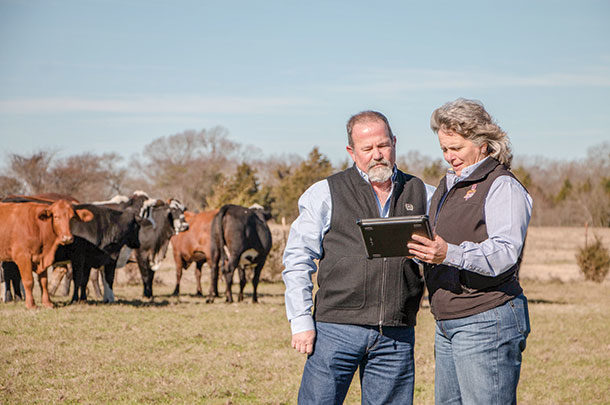Regardless of the era, the goal has always been to use records to generate usable information in order to make informed decisions.
Why keep ranch records?
A common goal in keeping ranch records is to be able to know which cows truly are productive and which cows are not pulling their own weight. Though a visual appraisal is important, there is often much more to a cow’s productivity that can only be realized through ranch records.
In addition to on-farm management needs, ranch records are also critical for accounting and tax purposes. While some producers simply give their accountant a shoebox of receipts and a “good luck,” they often sell themselves short by leaving the details up to their accountant to piece together.
On the other hand, a good set of ranch records helps you know how your ranch is performing throughout the year. Tax time goes from a “tossing over the fence” to a painless process that is as simple as printing a few reports and turning them in.
Also, those working with farm credit lenders, extension agents, veterinarians and herd consultants will find ranch records are critical to ensuring a productive and successful relationship.
Deciding on information to collect
Choosing the information to collect is a lot like the fairy tale “Goldilocks and the Three Bears.” In the fairy tale, Goldilocks finds the home of three bears. Throughout the story, she finds soup that is too hot, too cold and just right. Also, she finds beds that are too soft, too hard and, finally, one that is just right.
This concept of too much, too little and just right also applies to recordkeeping. As you decide on the information to collect, it’s important to keep reporting needs in mind. If you don’t collect enough, you will not be able to achieve your management goals. However, if you keep too much information, you will burden yourself with collecting data that is never used.
I find it helpful to start backward and first ask myself what reports and information I need to make decisions. From there, it’s easy to back into the information required to generate these reports. You will find your record-keeping needs change as your process evolves over time.
Choosing between paper, spreadsheets or software
Many producers use paper and notebooks to keep their cattle records. While the cost is nice, paper records just don’t offer a lot of benefits for achieving long-term record-keeping goals. More importantly, paper records do not offer a way of processing calculations or generating reports. What you’ve written down on the paper is what you get.
 Spreadsheets, a common choice for producers looking to organize their records, can be a great way to get started. Sometimes they can also be enough for those who are only collecting a few pieces of data for inventory purposes. However, it is easy for producers to outgrow spreadsheets when maintaining historical data such as previous calvings, health treatments, breeding and weights. At that point, the records start spreading across many columns and tabs, creating spreadsheet spaghetti.
Spreadsheets, a common choice for producers looking to organize their records, can be a great way to get started. Sometimes they can also be enough for those who are only collecting a few pieces of data for inventory purposes. However, it is easy for producers to outgrow spreadsheets when maintaining historical data such as previous calvings, health treatments, breeding and weights. At that point, the records start spreading across many columns and tabs, creating spreadsheet spaghetti.
Those who are serious about long-term ranch recordkeeping will use software designed for ranch recordkeeping. The benefits of a database for storing ranch records is: The information is stored in an organized manner so it can be retrieved for effective reporting.
Organizing your cattle records
After deciding the information you want to collect, the next step is to organize your records. This means getting the shoebox in the hall closet, gathering the slips of paper out of pockets, grabbing the notebook off the dashboard and finding the rest of the ranch records. It’s a lot easier to start with everything in front of you rather than having to search as you are entering data.
When getting started, it’s best to begin with an active animal inventory – the animals on your ranch today. After creating your inventory, you can make note of the current information on these animals – breeding exposures, pregnancy information, calves at side, locations, descriptive, etc.
Only after you have a current inventory should you start entering data on previous calves, sales histories, pedigrees and other historical information. By entering all active information first, you can begin managing your herd today as you fill in historical information on those bad-weather days.
Reaping the rewards of good recordkeeping
Many years ago, a colleague, Louis Martin, said “A record-keeping system without reporting and analysis is simply an electronic file cabinet.”
It still amazes me today how many record-keeping systems fail to generate more than basic lists of data, simply printed out exactly as entered. A big benefit of a computer-based cattle record-keeping system is the ability to turn basic pieces of data, such as dates, weights and pasture exposures, into useful information.
With birth and weaning dates and weights, a producer can compute useful calculations, including 205-day adjusted weaning weights and ratio/index contemporary groups. With a cow’s historical calving dates, average calving interval and average postpartum interval can be calculated. These types of calculated values enable a producer to compare animals within their herds in a true apples-to-apples comparison.
In addition to herd comparison reports, individual animal reports can be helpful to producers when making breeding and culling decisions, as well as when marketing animals to prospective buyers.
Conclusion
Though ranch recordkeeping may sound like a time-consuming chore, it should be seen as a critical ranch activity to ensure ongoing success, both from a production as well as a financial perspective. By starting with your reporting needs and working backward, you can clearly define the information you will need to collect. Once that information is defined, you are ready to organize and gather up your records for input. Remember, inch by inch is a cinch. ![]()
PHOTO 1: Recordkeeping may sound like a time-consuming chore, but it is critical to ongoing ranch success.
PHOTO 2: Using software designed for ranch recordkeeping can help producers do more with the information they are collecting. Photos by Jamie Baldwin.

-
Terrell Miller
- Founder
- Cattlesoft Inc.
- Email Terrell Miller







